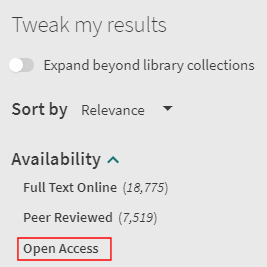Open Access Indication in Primo
If you are working with Primo VE and not Primo, see Open Access Indication in Primo VE.
Introduction
Primo displays a flag and enables users to filter items with content that is open access. This article describes the Open Access indication and facet. In addition, it describes how the feature works and how items are flagged as Open Access for Community Zone (CZ) and local records.
For more information on how Open Access content is handled in CDI, see Open Access Content in CDI.
This feature is available in the new Primo UI only.
Open Access Indication and Facet in Primo
When items are marked as Open Access in either the Central Index or CZ and local records, an Open Access indication appears in the brief results and the full view of the record in Primo so that users can easily identify items that are not restricted to view their content.

In addition, an Open Access facet enables users to filter results to display only open access content. For Primo, the Availability facets do not display the record counts.

Hiding the Open Access Indication
If you would like to hide the Open Access text and icon, add the following lines to your view's CSS:
/* Hide the open-access text and icon */
.open-access-mark span {
display: none;
}
.open-access-mark-icon md-icon {
display: none;
}
Linking to Open Access Content from the Primo Results Page
Linking in CDI is supported either by the Alma/SFX Link Resolver or by the link within the CDI records. The proxy configuration is managed accordingly in two different places. Both places allow to create exceptions for records that are flagged as open access.
-
In Alma/SFX you can define the proxy settings for links that are generated by the Link Resolver (LinkResolver collections). For more details, see Managing Electronic Resources (Alma) and SFX General Users Guide (SFX).
-
In Primo you can define proxy settings for Link in Record type of links. For more details, see the configuration options under the EZproxy field section.
With the Primo November 2022 release, a new Open Access indication is available for links returned by CDI. For all CDI links that have this link-level Open Access indication, the proxy configuration settings in Primo are used to determine whether a proxy is added or not. For more details on this link-level Open Access indication and how it affects linking, see Remove Proxy Prefix for Open Access Links.
Open Access Content from the Community Zone
Relevant journals from the Alma Community Zone are enriched with the following MARC information so that they display the Open Access indicator in Primo:
This indication is automatically added only to bibliographic records that are linked to Directory of Open Access Journals (DOAJ) portfolios.

